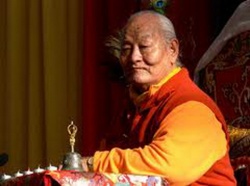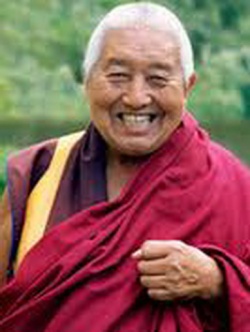On tradition and scholarship, two rivers and one sea
Chogyal Namkhai Norbu’s London retreat this September overlaped with the School of Oriental and African Studies international conference on ‘Bon, Shangshung, and Early Tibet’. Rinpoche spoke at the conference along side Professor Samten Karmay and (via video) Lopen Tenzin Namdak, as well as a group of prominent western scholars. This was a rare treat as each of these contributors have had an enormous influence on our reception and understanding of the Great Perfection in the West. However what is a little surprising is that while Norbu Rinpoche and Tenzin Namdak represent the Buddhist and Bon traditions of the Great Perfection, Samten Karmay represents the western scholarly tradition of textual analysis. Bringing these two often contradictory approaches together is an unusual and challenging event.
Samten Karmay, a Bonpo Geshe, is a few years older than Norbu Rinpoche. After meeting the eminent Tibetologist David Snellgrove he came to England and SOAS with Tenzin Namdak in the early 1960’s and eventually left with a Ph.D and the research material that enabled him to write his profoundly influential “The Great Perfection” – a book that has formed the opinions of all subsequent scholars of the subject. In this work Karmey enquires into the origins of the Great Perfection tradition and arrives at a surprising answer for us: based on the textual evidence, the Great Perfection, as a separately identified vehicle, probably did not exist until the late ninth century CE. That is, the tradition is little more than a thousand years old.
Karmay arrives at this view mainly by two pieces of evidence. He says that the Great Perfection emerged primarily from Indian Tantrism. Four times in the eighth century Guhyagarbha Tantra, the principle tantra of the Mahayoga class, is found the expression ‘great perfection’. These instances, he believes, are the first seeds of the Great Perfection emerging as a tradition in its own right. Backing this up he turns to the famous “Garland of Views”, a commentary of uncertain date on the Guhyagarbha Tantra attributed to Guru Padmasambhava. This is an early arrangement of the Nyingma nine vehicle system where, Karmay argues, the Great Perfection, whilst being the ultimate view, has yet to achieve the status of a separate and distinct vehicle to realisation, rather it is still a sub-division of Mahayoga. So he is saying during the late seven hundreds and early eight hundreds, while the contents of what we would recognise as the Great Perfection teaching may have existed in seminal form, the Great Perfection as a separate tradition did not.
Others have followed this view including John Reynolds, known to us as a translator of Great Perfection texts, and two scholars, David Germano and Sam van Schaik who now translates the Dunhuang documents in which very early Great Perfection material has been found. Van Schaik takes Karmay’s ideas and fills them out demonstrating how the seeds of a Great Perfection tradition came into full bloom. He says that masters of Mahayoga began to write commentaries on it from what we would now recognise as a Great Perfection perspective. These proliferated into a growing body of teachings that were finally gathered together by Nub Sangye Yeshe at around the late ninth – early tenth century in his unique “Lamp for the Eyes of Contemplation”. In this work he draws on many different emergent proto-Great Perfection views and unites them under a single rubric, the “The Great Perfection” as a separate and distinct vehicle for the first time.
David Germano follows suit, yet here there is a small breaking of ranks. While Germano accepts the Indian Tantrism theory he also notes that the simplicity of the earliest Sems sde contemplations is reminiscent of the earlier still Mahayana insight meditations on emptiness. More radically he also suggests that the generation and completion stages of a Mahayoga sadhana were originally two separate parts. The active and intentioned visualisation of the deity in the generation stage being later joined by the addition of a formless meditation on emptiness, taken from an earlier strata of Buddhism and newly appended as the completion stage in which the visualisation dissolves into its formless, empty ground. With these ideas in mind Germano then asks whether the first Sems sde contemplations had their roots in the earliest Buddhist practice of shamatha and vipashyana, calm and insight, which was then ‘pasted’ into tantrism as the completion stage and then continued its own separate journey, perhaps bouncing off Chan, to emerge finally as the Great Perfection?
So what are we to think of this? Plainly the traditional and scholarly accounts do not agree. We may try to reconcile them by remembering the age of a manuscript is not necessarily the same as its content and also that much of this scholarly speculation remains unsubstantiated. However this does not remove the common sense observations that all teachings create in retrospect mythologised histories that big up a more obscure and probably human past. That the tradition is more interested in encouraging devotion then establishing an accurate history in any Western sense. However there are places where the tradition and scholarship do agree.Norbu Rinpoche and Kennard Lipman’s translation of “Gold Refined From Ore”, a very early Great Perfection text ascribed to Manjushrimitra, does not use the rubric ‘The Great Perfection’ to describe its teaching thereby confirming that Great Perfection teachings did exist prior to the existence of the Great Perfection as the ninth vehicle – just as Karmay, Germano and van Schaik suggest. However, even allowing this, irresolvable competing explanations, traditional and scholarly, still remain.
The struggle between these two perspectives and the anxiety it can generate may be witnessed in the blogs left on Sam van Schaiks excellent web site ‘Early Tibet’. His writings on the origins of the Great Perfection as a tradition have clearly unsettle some of us who have personally identified with the tradition and the mythologised accounts of its beginnings. Reflecting on my own anxiety when I first came across the ideas of Karmay et al. I realised that unthinkingly I had come to believe that old equals a greater truth while more recent equalled “just made up”. On reflection this now seems silly. All teachings have a beginning, middle and end and this does not diminish their validity as a means to end suffering. Now, with further reflection, it seems to me that what really generates devotion in me is an appreciation of the extraordinary subtlety married to exquisite simplicity that the Great Perfection view embodies. Further more, even though we may not know with any historical certainty who were the first yogins to discovered and master the Great Perfection as a contemplative realisation, what is certain is their passion and dedication and also their motivation to bring the suffering of all beings to an end forever. A motivation, no doubt continued and embodied by the masters at SOAS this september.
Nigel Wellings 2011


